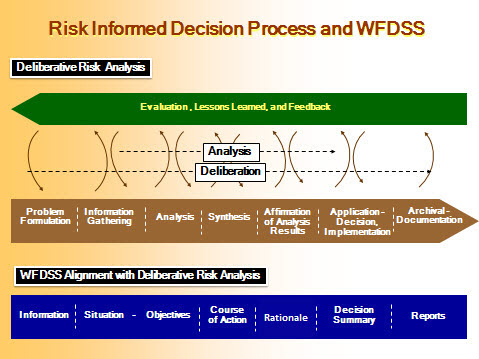Decision Making: An Analytic Deliberative Process
Risk-informed decision making requires two distinct but linked processes: analysis and deliberation. Analysis involves the rigorous, replicable methods to provide information about factual questions. While analysis brings new information into the decision making process, it informs the deliberation. Deliberation is the discussion, reflection, and persuasion to communicate, raise issues, collectively consider issues, increase understanding, and facilitate substantive decisions. New analyses are framed as deliberation brings new insights, questions, and problem formulations.
Figure 1: Risk Informed Decision Process WFDSS

The top portion of the slide shows a risk informed decision process through analysis and deliberation. The blue strip at the bottom of the slide shows the WFDSS decision flow process and how it lines up with the deliberative risk informed decision process. In WFDSS the INFORMATION tab is the Problem Formulation of risk informed decision making. SITUATION and OBJECTIVES provide the Information Gathering and Analysis of the risk informed process. The COURSE OF ACTION is the Synthesis. RATIONALE is the Thought Process and Affirmation of Analysis results. DECISION SUMMARY is the Application-Decision Implementation. REPORTS aligns with the Archival Documentation.
-----------
Last updated on 9/27/2016 2:09:05 PM.
In This Section |
See Also |
Reference |